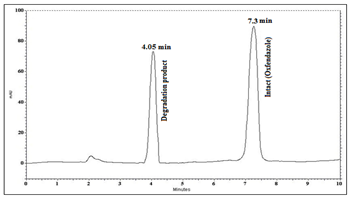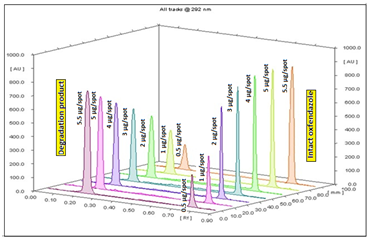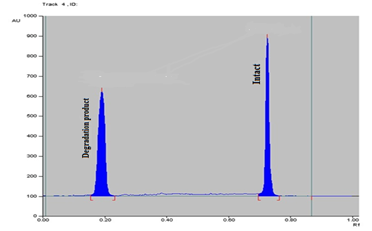Journal of
eISSN: 2473-0831


Accurate, selective, and sensitive reversed phase high performance liquid chromatography (RP-HPLC) and thin-layer chromatography (TLC) - densitometry methods have been developed and validated for determination of oxfendazole in the presence of its alkali-induced degradation product. The developed RP-HPLC method was based on the separation of the two components using 0.05M KH2PO4 (adjusted to pH=5), methanol and actonitrile (50:30:20, by volume) as a mobile phase in isocratic elution mode on BDS Hypersil C18 column at a flow rate of 1mL min−1 and ultraviolet (UV) detection at 225nm. The components were well resolved from each other with significantly different Rt values of 7.3 and 4.05min for oxfendazole and its alkali-induced degradation product, respectively. The method was applied in the range of (3-15µg mL-1). On the other hand, TLC- densitometric method depends on the separation and quantitation of oxfendazole and its alkali-induced degradation product on TLC silica gel 60 F254 plates, using chloroform-methanol and glacial acetic acid (90:8:2, by volume) as the developing system followed by densitometric measurement at 292nm. The studied components were well resolved from each other with significantly different Rf values of 0.75 and 0.2 for oxfendazole and its degradation product, respectively. The method was applied in the range of (0.5-6µg /spot). The developed methods were validated according to the International Conference on Harmonization (ICH) guidelines demonstrating good accuracy and precision. The results were statistically compared with those obtained by the reported method, and no significant difference was found.
Keywords: oxfendazole, oxfendazole degradation product, RP-HPLC and TLC-densitometry
Oxfendazole chemically known as: [5-(Phenylsulfinyl)-1H-benzimidazol-2-yl] carbamic acid methyl ester1Figure 1. It is a benzimidazole carbamate anthelmintic used in veterinary medicine.2 Different analytical techniques were applied for quantitative estimation of oxfendazole including potentiometric titration,3,4 radio immunoassay,5 spectrophotometric methods6 and HPLC methods even alone or in presence of other compounds.7–17 Oxfendazole is an amide group containing compound that made it highly sensitive to hydrolytic degradation in basic conditions with the production of the degradation product 2-amino-5-Phenylsulfinyl benzimidazole. There is no stability indicating analytical methods were reported for determination of oxfendazole in presence of its degradation product. The aim of this work is to develop and validate simple, sensitive and selective chromatographic methods for the determination of oxfendazole in presence of its alkali-induced degradation product (2-amino-5-Phenylsulfinyl benzimidazole) without preliminary separation. The proposed methods were found to be fast and simple and can be used for its routine analysis in quality control laboratories.
Instruments
Pure standard
Standard oxfendazole powder was kindly supplied by Unipharma Co. for pharmaceutical industries, Al Obour city, Cairo, Egypt. (B. NO.60414005).
Pharmaceutical preparation
Unifendazole® suspension, the product of Unipharma Co. for pharmaceutical industries, AlObour city, Cairo, Egypt. (B.NO.390215), which labeled to contain 22.5% w/v oxfendazole.
Reagents and solvents
Degraded sample
One gram of oxfendazole was dissolved in 25mL 0.1M methanolic hydrochloric acid, and then transferred into 250mL conical flask, then 50mL of 1M NaOH solution was added. The flask was heated to boiling under reflux for 1hr, cooled and neutralized with 1M HCl. Subsequently, the solution was dried under vacuum then the degradation product was extracted with methanol and re-crystallized after evaporating methanol.
Standard solutions
Construction of calibration curves
RP-HPLC method: Aliquots of oxfendazole equivalent to (30-150μg), were accurately transferred from its respective working standard solution (100μg mL-1) into a set of 10mL volumetric flasks and the volume was then completed to the mark with the mobile phase [potassium dihydrogen phosphate (pH=5): methanol: acetonitrile] (50:30:20, by volume). A 20μL aliquot of each solution was injected into a BDS Hypersil C18 column (4.6×250mm), particle size (5μm), using the mobile phase, at flow rate 1.0mL min-1 and UV detection at 225nm. Calibration curve was constructed by plotting the peak area against the corresponding concentrations of oxfendazole.
TLC-densitometry method: Accurately measured aliquots of oxfendazole stock standard solution (1 mg mL-1) were spotted onto TLC plate using Camag Linomat auto sampler with micro syringe (100μL). The plate was then developed by the ascending technique using chloroform: methanol: acetic acid (90:8:2, by volume) as a mobile phase. The plate was then removed and air-dried. The chromatogram was scanned at 292 nm. Calibration curve representing the relationship between integrated peak area and the corresponding concentrations of oxfendazole was plotted.
Application to laboratory prepared mixtures
Aliquots of oxfendazole and its degradation product were mixed to prepare different mixtures containing different ratios of both. The procedures mentioned under construction of calibration curves were followed and the concentrations of oxfendazole were calculated.
Application to pharmaceutical formulation
Volume of Unifendazole® suspension (22.5 w/v oxfendazole) equivalent to 250mg oxfendazole was accurately taken and dissolved in 10mL 0.1M methanolic hydrochloric acid in 250mL flask then complete to volume with methanol, shacked, and then filtered to obtain a solution labeled to contain (1mg mL-1) of oxfendazole. 10mL of the filtrate were accurately transferred into 100mL volumetric flask then complete to volume with methanol to obtain a solution labeled to contain (100µg mL-1) of oxfendazole. The solution was analyzed using the procedures described previously.
Degradation of oxfendazole
It is found that complete alkaline degradation of oxfendazole was obtained after refluxing the drug with 1M sodium hydroxide at 100°C for 1hr, and the degradation was confirmed by TLC method using chloroform: methanol: acetic acid (90:8:2, by volume) as a developing system, where a suggested degradation pathway is shown as follows:
Identification of the degradation product: Infra red (IR) spectrum of the degradation product showed abroad peak at 3404cm-1 which may be assigned to the primary amine group, also disappearance of the peaks at 2741cm-1 of the methyl group and at 1724cm-1 of the carbonyl group, (Figure 2 & Figure 3). Mass spectrometry showed that the compound has a molar mass of 256.96 indicating the presence of the degradation product, (Figure 4 & Figure 5).
In conclusion, all the above evidences indicate that the degradation product could be 2-amino-5-Phenylsulfinyl benzimidazole, (Scheme 1). The suggested chromatographic system for the HPLC method allows complete base line separation at reasonable time.18 Planar chromatography with precise application of the samples and computer controlled evaluation and quantification of the developed chromatograms has been considered to be a reliable technique for purity control and for quantitative drug testing.19
Chromatographic conditions: Several trials were applied to develop the optimum chromatographic conditions for the sufficient separation of oxfendazole and its degradation product.
HPLC method was applied to separate oxfendazole and its degradation product, therefore several trials have been undertaken to reach the optimum stationary/mobile phases matching. Good chromatographic separation of the two components in their mixtures could be achieved by using BDS Hypersil C18 column (4.6×250mm), particle size (5μm), with a mobile phase consisting of (potassium dihydrogen phosphate (pH 5): methanol: acetonitrile (50:30:20, by volume) at flow rate 1.0mL min-1, followed by UV detection at 225nm, (Figure 6). The results of the TLC system were satisfactory when using chloroform: methanol: acetic acid (90:8:2, by volume) as the developing system. Rf values were found to be 0.75 and 0.20 for oxfendazole and its degradation product, respectively as shown in (Figures 7-9). This separation allows the determination of oxfendazole at 292nm without any interference from its degradation product.

Figure 6 HPLC chromatogram of mixture of intact oxfendazole (10µg mL-1) and its degradation product (10µg mL-1)

Figure 8 3D TLC- densitometric chromatogram of oxfendazole (0.5-5.5µg/spot) and its degradation product (5.5-0.5µg/spot) at 292nm.

Figure 9 2D TLC- densitometric chromatogram of intact oxfendazole (3µg/spot) and its degradation product (3µg/spot) at 292nm.
Methods validation: Validations of the proposed methods were assessed as per the ICH guidelines20 of accuracy, precision, repeatability, interday precision, linearity.
Linearity and range: Calibration graphs were constructed by plotting the area under peak versus drug concentrations. The regression plot was found to be linear over the range of (3-15µg mL-1) for RP-HPLC method and over the range of (0.5-6µg/spot ) for TLC-densitometric method. The linear regression equations for the graphs were:
y=139699x–2848.1………………… (r2=0.9998), for RP-HPLC method.
y=1188.4x+4641.8 ………………… (r2=0.9996), for TLC-densitometric method.
Where y is the area under peak values, x is the drug concentration and r2 is the determination coefficient. Linearity range, regression equation, intercept, slope and determination coefficient for the calibration data were presented in Table 1.
Limits of detection and quantitation: The limits of detection (LOD) and the limits of quantitation (LOQ) were calculated according to ICH guidelines from the following equations:
LOD=3.3σ/S LOQ=10σ/S
Where σ is the standard deviation of y-intercepts of regression lines and S is the slope of the calibration curve. LOD and LOQ values were mentioned in Table 1.
|
Parameter |
RP-HPLC method |
TLC-densitometric method |
|
Accuracy (mean±RSD)a |
100.25±0.447 |
100.10±0.385 |
|
Precision |
||
|
Repeatability (RSD)b |
0.3 |
0.48 |
|
Intermediate precision (RSD)c |
0.307 |
0.477 |
|
Wavelength |
225nm |
292nm |
|
Linearity range |
(3-15µg mL-1) |
(0.5-6µg/spot) |
|
Slope |
139699 |
1188.4 |
|
Intercept |
-2848.1 |
4641.8 |
|
Cofficient of determination (r2) |
0.9998 |
0.9996 |
|
LOD |
0.144µg mL-1 |
0.093µg/spot |
|
LOQ |
0.436µg mL-1 |
0.282µg/spot |
Table 1 Assay validation sheet of the proposed methods
aAverage of three determinations for three concentrations (5,10 and 15µg mL-1 for RP-HPLC method), and (1,3 and 5µg/spot for TLC-densitomrtic method) of oxfendazole repeated three times.
bThe intraday (n=3), average of three concentrations (5,10 and 15µg mL-1 for RP-HPLC method), and (1,3 and 5µg/spot for TLC-densitomrtic method), of oxfendazole repeated three times within the day.
cThe interday (n=3), average of three concentrations (5,10 and 15µg mL-1 for RP-HPLC method), and (1,3 and 5µg/spot for TLC-densitomrtic method), of oxfendazole repeated three times in three days.
Accuracy: The proposed methods were applied for measuring different concentrations of oxfendazole within their linearity range and the concentrations were calculated each from their corresponding regression equations. The accuracy of the proposed methods was calculated and RSD% was obtained. Good results were obtained as shown in Table 1.
Precision: Precision was evaluated by calculating intraday (repeatability) and interday (Intermediate precision) precision after repeating measuring of the three different concentrations three times in the same day and assaying the sample in triplicate on three successive days using the proposed methods. The calculated RSD % values were listed as shown in Table 1 indicating satisfying precision of the proposed methods.
Specificity: The specificity of the proposed methods was assured by applying them to laboratory prepared mixtures of the intact oxfendazole together with its degradation product. The proposed procedures were adopted for the selective determination of intact oxfendazole in presence of up to 80% of its degradation product for RP-HPLC method and up to 91.67% for TLC-densitometric method. The mean percentage recovery ±SD % was shown in Table 2. The validity of the proposed procedures is further assessed by applying the standard addition technique showing no interference from excipients. The results obtained were shown in Table 3. System suitability parameters were calculated for oxfendazole in RP-HPLC method and the results are shown in Table 4.
|
Method |
Intact in (µg mL-1) |
Degradate in (µg mL-1) |
Percent of degradate |
Intact found in (µg mL-1) |
Recovery % of intact |
|
RP-HPLC |
12 |
3 |
20% |
12.15 |
101.28 |
|
10 |
5 |
33.33% |
10.03 |
100.32 |
|
|
5 |
10 |
66.67% |
5.04 |
100.88 |
|
|
3 |
12 |
80% |
3.05 |
101.87 |
|
|
Mean ± SD% |
|
101.09±0.655 |
|||
|
|
Intact in (µg/spot) |
Degradate in (µg/spot) |
Percent of degradate |
Intact found in (µg/spot) |
Recovery % of intact |
|
TLC-densitometric |
5.5 |
0.5 |
8.33% |
5.46 |
99.27 |
|
5 |
1 |
16.67% |
4.94 |
98.77 |
|
|
3 |
3 |
50% |
2.96 |
98.96 |
|
|
1 |
5 |
83.33% |
0.99 |
99.14 |
|
|
0.5 |
5.5 |
91.67% |
0.49 |
98.14 |
|
|
Mean ± SD% |
|
98.95 ±0.424 |
|||
Table 2 Determination of oxfendazole in presence of its alkali- degradation product in their laboratory prepared mixtures by the proposed methods
|
Method |
Pharmaceutical Taken(µg/mL) |
Pure added (µg mL-1) |
Pure found (µg mL-1) |
Recovery % |
|
RP-HPLC |
5 |
3 |
2.99 |
99.76 |
|
5 |
4.98 |
99.65 |
||
|
7 |
7.01 |
100.13 |
||
|
10 |
10.03 |
100.35 |
||
|
Mean±SD% |
99.97±0.326 |
|||
|
TLC-densitometric |
2 |
1 |
0.98 |
98.65 |
|
2 |
1.96 |
98.38 |
||
|
3 |
2.97 |
99.19 |
||
|
4 |
3.97 |
99.24 |
||
|
Mean±SD% |
98.86±0.417 |
|||
Table 3 Application of standard addition technique to the analysis of Unifendazole® suspension by applying the proposed methods
|
Parameter |
Oxfendazole |
Reference values21 |
|
Resolution (R) |
6.5 |
R >1.5 |
|
Selectivity factor (α) |
2.66 |
>1 |
|
Retention time (tR) |
7.3 min |
|
|
Capacity factor (K´) |
2.47 |
1–10 |
|
Theoretical plates (N) |
2370 |
|
|
Tailing factor (T) |
1.15 |
T=1 for a typical symmetric peak |
Table 4 Parameters of the system suitability test of the HPLC method
Statistical analysis
In order to compare the ability of the proposed methods for the determination of oxfendazole in pharmaceutical preparation, the results obtained by applying each of the proposed methods and the reported spectrophotometric method (6) were subjected to statistical analysis Table 5. The calculated t and F values were less than the theoretical ones indicating that there were no significant differences between the proposed and the reported methods.
|
|
RP-HPLC |
TLC-densitometric |
Reported method6 |
|
n* |
5 |
5 |
5 |
|
X‾ |
99.83 |
99.48 |
99.85 |
|
SD |
0.746 |
0.653 |
0.478 |
|
RSD% |
0.747 |
0.656 |
0.479 |
|
t** |
0.060(2.306) |
1.021(2.306) |
—— |
|
F** |
2.427(6.388) |
1.846(6.388) |
—— |
Table 5 Statistical comparison for the results obtained by the proposed methods and the reported method for the analysis of oxfendazole in Unifendazole® (22.5% w/v) suspension
*No. of experiment
**The values in the parenthesis are tabulated values of t and F at p=0.05 level of significance
In this work, two chromatographic methods were developed and applied for the determination of oxfendazole in the presence of its alkali-induced degradation product. The advantage of the TLC-densitometric method is that several samples can be run simultaneously using a small quantity of the mobile phase, thus lowering the analysis time and cost per analysis, as well as providing high sensitivity and selectivity. The proposed methods were successfully applied to Unifendazole® suspension and no interference from pharmaceutical formulation excipients was found.
I am deeply thankful to ALLAH, by the grace of whom this work was realized. I wish to express my indebtedness and gratitude to staff members Pharmaceutical Analytical Chemistry Department, Faculty of Pharmacy Al-Azhar University, Cairo, Egypt for their valuable supervision, continuous guidance, and encouragement throughout the whole work.
The author declares there is no conflict of interest.

© . This is an open access article distributed under the terms of the, which permits unrestricted use, distribution, and build upon your work non-commercially.